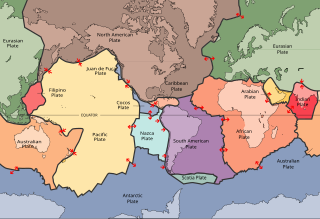Related Research Articles

Plate tectonics is the scientific theory that Earth's lithosphere comprises a number of large tectonic plates, which have been slowly moving since about 3.4 billion years ago. The model builds on the concept of continental drift, an idea developed during the first decades of the 20th century. Plate tectonics came to be accepted by geoscientists after seafloor spreading was validated in the mid-to-late 1960s.

Geophysics is a subject of natural science concerned with the physical processes and physical properties of the Earth and its surrounding space environment, and the use of quantitative methods for their analysis. Geophysicists, who usually study geophysics, physics, or one of the Earth sciences at the graduate level, complete investigations across a wide range of scientific disciplines. The term geophysics classically refers to solid earth applications: Earth's shape; its gravitational, magnetic fields, and electromagnetic fields ; its internal structure and composition; its dynamics and their surface expression in plate tectonics, the generation of magmas, volcanism and rock formation. However, modern geophysics organizations and pure scientists use a broader definition that includes the water cycle including snow and ice; fluid dynamics of the oceans and the atmosphere; electricity and magnetism in the ionosphere and magnetosphere and solar-terrestrial physics; and analogous problems associated with the Moon and other planets.

A lithosphere is the rigid, outermost rocky shell of a terrestrial planet or natural satellite. On Earth, it is composed of the crust and the lithospheric mantle, the topmost portion of the upper mantle that behaves elastically on time scales of up to thousands of years or more. The crust and upper mantle are distinguished on the basis of chemistry and mineralogy.

The asthenosphere is the mechanically weak and ductile region of the upper mantle of Earth. It lies below the lithosphere, at a depth between ~80 and 200 km below the surface, and extends as deep as 700 km (430 mi). However, the lower boundary of the asthenosphere is not well defined.

Harry Hammond Hess was an American geologist and a United States Navy officer in World War II who is considered one of the "founding fathers" of the unifying theory of plate tectonics. He published theories on sea floor spreading, specifically on relationships between island arcs, seafloor gravity anomalies, and serpentinized peridotite, suggesting that the convection in the Earth's mantle is the driving force behind this process.
Tectonophysics, a branch of geophysics, is the study of the physical processes that underlie tectonic deformation. This includes measurement or calculation of the stress- and strain fields on Earth’s surface and the rheologies of the crust, mantle, lithosphere and asthenosphere.
Dan Peter McKenzie is a Professor of Geophysics at the University of Cambridge, and one-time head of the Bullard Laboratories of the Cambridge Department of Earth Sciences. He wrote the first paper defining the mathematical principles of plate tectonics on a sphere, and his early work on mantle convection created the modern discussion of planetary interiors.

Don Lynn Anderson was an American geophysicist who made significant contributions to the understanding of the origin, evolution, structure, and composition of Earth and other planets. An expert in numerous scientific disciplines, Anderson's work combined seismology, solid state physics, geochemistry and petrology to explain how the Earth works. Anderson was best known for his contributions to the understanding of the Earth's deep interior, and more recently, for the plate theory hypothesis that hotspots are the product of plate tectonics rather than narrow plumes emanating from the deep Earth. Anderson was Professor (Emeritus) of Geophysics in the Division of Geological and Planetary Sciences at the California Institute of Technology (Caltech). He received numerous awards from geophysical, geological and astronomical societies. In 1998 he was awarded the Crafoord Prize by the Royal Swedish Academy of Sciences along with Adam Dziewonski. Later that year, Anderson received the National Medal of Science. He held honorary doctorates from Rensselaer Polytechnic Institute and the University of Paris (Sorbonne), and served on numerous university advisory committees, including those at Harvard, Princeton, Yale, University of Chicago, Stanford, University of Paris, Purdue University, and Rice University. Anderson's wide-ranging research resulted in hundreds of published papers in the fields of planetary science, seismology, mineral physics, petrology, geochemistry, tectonics and the philosophy of science.

Mantle convection is the very slow creep of Earth's solid silicate mantle as convection currents carry heat from the interior to the planet's surface. Mantle convection causes tectonic plates to move around the Earth's surface.

Geodynamics is a subfield of geophysics dealing with dynamics of the Earth. It applies physics, chemistry and mathematics to the understanding of how mantle convection leads to plate tectonics and geologic phenomena such as seafloor spreading, mountain building, volcanoes, earthquakes, faulting. It also attempts to probe the internal activity by measuring magnetic fields, gravity, and seismic waves, as well as the mineralogy of rocks and their isotopic composition. Methods of geodynamics are also applied to exploration of other planets.

Earth's internal heat budget is fundamental to the thermal history of the Earth. The flow of heat from Earth's interior to the surface is estimated at 47±2 terawatts (TW) and comes from two main sources in roughly equal amounts: the radiogenic heat produced by the radioactive decay of isotopes in the mantle and crust, and the primordial heat left over from the formation of Earth.
Louise H. Kellogg was an American geophysicist with expertise in chemical geodynamics and computational geophysics and experience in leading multidisciplinary teams to advance geodynamics modeling and scientific visualization. Kellogg was a Distinguished Professor at the University of California, Davis and director of the Computational Infrastructure for Geodynamics. She was also a major contributor to the Deep Carbon Observatory project of the Sloan Foundation.
David Gubbins is a British former geophysicist concerned with the mechanism of the Earth's magnetic field and theoretical geophysics. He is Emeritus Professor of Earth Sciences at Leeds University.
Maureen D. Long is an observational seismologist studying mantle and Mesosphere dynamics. She currently serves as a professor at Yale University within the Department of Geology and Geophysics.
Alik Ismail-Zadeh is a mathematical geophysicist known for his contribution to computational geodynamics and natural hazard studies, pioneering work on data assimilation in geodynamics as well as for outstanding service to the Earth and space science community. He is Senior Research Fellow at the Karlsruhe Institute of Technology in Germany.
Claude Jaupart is a French geophysicist and a member of the French Academy of Sciences.
Donald "Don" William Forsyth is an American geophysicist and seismologist, known for his research on the oceanic lithosphere and the oceanic aesthenosphere.
Richard G. Gordon is an American geophysicist, known for his research on global tectonics, including global plate motions and palaeomagnetism. He is noteworthy for leading two global plate motion projects: NUVEL and MORVEL. In the geosciences, NUVEL and MORVEL are standard models for global plate motions.
David A. Bercovici is an American geophysicist. He is primarily known for his theoretical explanations of why planet Earth has plate tectonics. He is also known for his development of models of how the Earth's mantle recycles and stores water and how such hydrological processes are involved in Earth's geochemical history.
References
- ↑ <Donald L. Turcotte. geo.cornell.edu
- ↑ "Mathematics Genealogy Project" . Retrieved 2024-05-20.
- ↑ Gates, Alexander E. (2003). "Turcotte, Donald L. (1932–)". A to Z of earth scientists. New York: Facts on File. pp. 265–266. ISBN 9781438109190.
- ↑ "Donald L. Turcotte".
- ↑ Turcotte, Donald L.; Oxburgh, E. Ronald (1969). "Continental drift". Physics Today. 22 (4): 30–39. Bibcode:1969PhT....22d..30T. doi:10.1063/1.3035524.
- ↑ "Bowie Medal Citation". www.agu.org. Retrieved 2016-07-28.
- ↑ "Donald Turcotte". www.nasonline.org. Retrieved 2016-07-22.
- ↑ "Donald L. Turcotte Award". www.agu.org. Retrieved 2016-08-06.